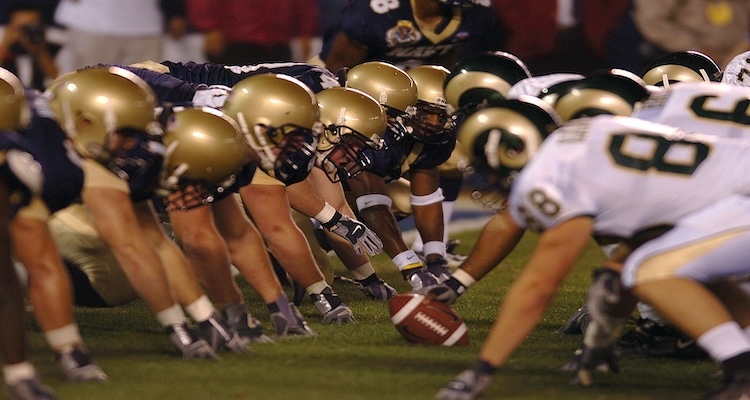
The 2024 college football season is set to be historic, as the NCAA has officially approved on-field sponsorships for the first time. This groundbreaking decision marks a significant departure from the traditional model that has governed college athletics for decades.
Today, we will explore the implications of the NCAA's decision to allow on-field sponsorships. We will discuss the potential benefits and drawbacks, examine the challenges the NCAA will face in implementing this new policy, and explore the potential impact on student-athletes and fans.
The NCAA's decision to allow several factors drive on-field sponsorships. Primarily, it aims to address the growing financial demands of college athletics. The costs of running a successful college football program have skyrocketed recently, including expenses for facilities, coaching salaries, and player scholarships. On-field sponsorships are a viable avenue to generate additional revenue and help offset these rising costs.
Moreover, the NCAA believes that on-field sponsorships can enhance the fan experience. The NCAA hopes to create a more engaging and visually appealing environment for fans by allowing companies to showcase their brands prominently on the field. This could increase attendance, viewership, and overall interest in college football.
The approval of on-field sponsorships presents potential benefits and concerns for the college football landscape. On the positive side, it could lead to a significant increase in revenue for college athletic departments. This additional funding could be used to invest in facilities, improve academic support services for student-athletes, and enhance the overall experience for athletes and fans.
However, there are also concerns about the potential impact of on-field sponsorships. Some critics argue that allowing corporate logos on the field could dilute college football's traditional values and aesthetics. They worry that the focus on commercialism could detract from universities' academic missions and create a more corporate-driven atmosphere.
Additionally, there are questions about the potential impact on student-athletes. Some argue that on-field sponsorships could create a more commercialized environment for athletes, potentially affecting their academic performance and overall well-being.
The approval of on-field sponsorships marks a significant milestone for the NCAA and college football. However, implementing this new policy will require careful consideration and planning. The NCAA will need to establish guidelines and regulations to ensure that on-field sponsorships are implemented in a way that is consistent with the values of college athletics and protects student-athletes interests.
One key challenge will be balancing sponsors' commercial interests with the integrity of the sport. The NCAA will need to carefully consider logo placement and ensure that they do not interfere with the game or distract from the action on the field. Additionally, the organization must establish guidelines for the size and placement of logos to prevent the field from becoming overly cluttered.
Another important consideration will be the potential impact of on-field sponsorships on student-athletes. The NCAA must ensure that athletes are not exploited commercially and that their academic performance is not compromised. It may be necessary to establish guidelines for how long athletes must participate in sponsorship activities and ensure they are adequately compensated.
Finally, the NCAA must address concerns about the potential impact of on-field sponsorships on the fan experience. While some fans may embrace the added commercialization, others may view it as a departure from college football's traditional values. The NCAA will need to strike a balance between generating revenue and preserving the sport's core values.
One of the most significant questions raised by the approval of on-field sponsorships is how it will affect student-athletes. While the NCAA has pledged to protect the interests of athletes, there are concerns that on-field sponsorships could create a more commercialized environment that could negatively impact their academic performance and overall well-being.
Some argue that athletes may feel pressure to prioritize sponsorship activities over their studies, leading to academic difficulties. Additionally, the increased exposure and attention that comes with on-field sponsorships could create a more demanding and stressful environment for athletes, potentially affecting their mental health.
However, there is also a potential upside for student-athletes. Increased revenue generated by on-field sponsorships could improve academic support services, enhance athletic facilities, and provide athletes with more resources to succeed both on and off the field.
However, it is important to ensure that on-field sponsorships do not detract from the excitement and pageantry of the College football playoffs. The NCAA will need to carefully consider the placement of logos and ensure that they do not interfere with the game or distract from the action on the field. Additionally, the organization will need to balance commercialization and preserving the traditional atmosphere of the CFP.
The approval of on-field sponsorships for college football is a landmark moment that has the potential to reshape the sport's landscape. While both benefits and concerns are associated with this new policy, it is clear that the future of college football will be significantly influenced by how on-field sponsorships are implemented.
As the NCAA continues to navigate this uncharted territory, it will be crucial to strike a balance between commercialization and preserving the integrity of the sport.
This is a Sponsored Post
